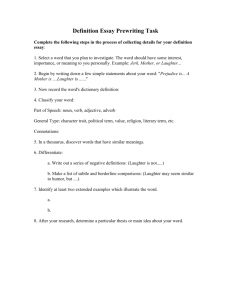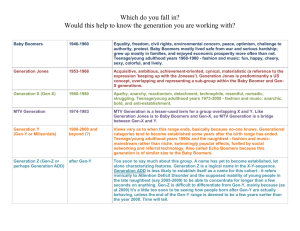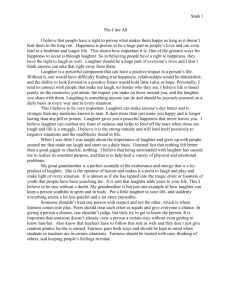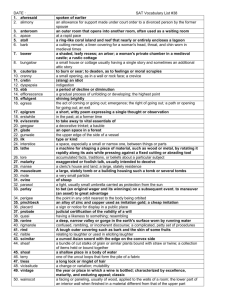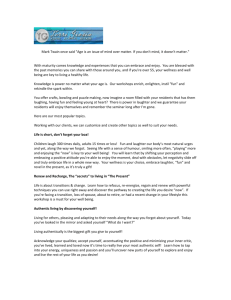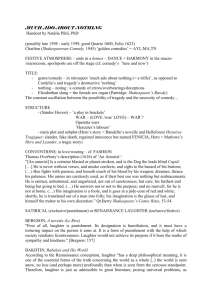The Connection between Laughter, Humor, and Good Health
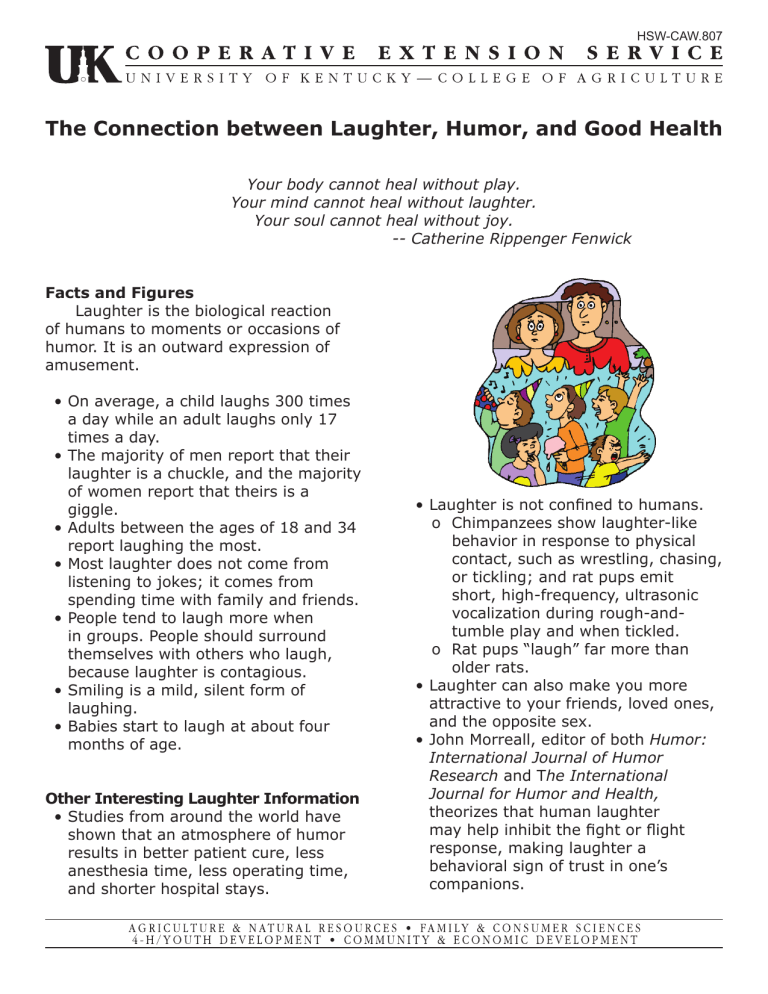
HSW-CAW.807
The Connection between Laughter, Humor, and Good Health
Your body cannot heal without play.
Your mind cannot heal without laughter.
Your soul cannot heal without joy.
-- Catherine Rippenger Fenwick
Facts and Figures
Laughter is the biological reaction of humans to moments or occasions of humor. It is an outward expression of amusement.
• On average, a child laughs 300 times a day while an adult laughs only 17 times a day.
• The majority of men report that their laughter is a chuckle, and the majority of women report that theirs is a giggle.
• Adults between the ages of 18 and 34 report laughing the most.
• Most laughter does not come from listening to jokes; it comes from spending time with family and friends.
• People tend to laugh more when in groups. People should surround themselves with others who laugh, because laughter is contagious.
• Smiling is a mild, silent form of laughing.
• Babies start to laugh at about four months of age.
Other Interesting Laughter Information
• Studies from around the world have shown that an atmosphere of humor results in better patient cure, less anesthesia time, less operating time, and shorter hospital stays.
• Laughter is not confined to humans.
o Chimpanzees show laughter-like behavior in response to physical contact, such as wrestling, chasing, or tickling; and rat pups emit short, high-frequency, ultrasonic vocalization during rough-andtumble play and when tickled.
o Rat pups “laugh” far more than older rats.
• Laughter can also make you more attractive to your friends, loved ones, and the opposite sex.
• John Morreall, editor of both Humor:
International Journal of Humor
Research and T he International
Journal for Humor and Health, theorizes that human laughter may help inhibit the fight or flight response, making laughter a behavioral sign of trust in one’s companions.
• Laughter sounds the same across cultures, leading some researchers to believe that laughter helped bond our ancestors together. In fact, the sound of laughter is so common and familiar that it can be recognized if played backwards on tape.
• Laughing burns calories. In fact, laughing for 10 minutes each day can burn the same number of calories as a half-hour workout.
• Laughter can be infectious. It can make others smile and feel happier. We are more likely to remember and want to be around the people who cheer us up and make us laugh.
The Health Benefits of
Humor and Laughter
Many people find that maintaining a sense of humor is useful for a good quality of life. Our sense of humor gives us the ability to find delight, experience joy, and release tension. Additionally, laughter activates the chemistry of the will to live and increases our capacity to fight disease, which makes it an effective self-care tool.
In 1979, Norman Cousins, MD wrote
Anatomy of Illness, which brought the subject of humor therapy to the attention of the medical community. In his book,
Dr. Cousins details how he used laughter to help ease his pain while undergoing treatment for an incurable and extremely painful inflammation of his body’s tissues.
As a result, scientific evidence on the effectiveness of humor and its health benefits is now overwhelming. The following are some of the researched benefits of laughter.
• Blood Pressure – People who laugh heartily, on a regular basis, have a lower standing blood pressure than does the average person. When people have a good laugh, initially the blood pressure increases, but then it decreases to levels below normal.
2
• Hormones – Laughter reduces at least four of the neuro-endocrine hormones associated with stress. These are epinephrine, cortisol, dopamine, and growth hormone.
• Immune System – Clinical studies by Lee Berk at Loma Linda University have shown that laughter strengthens the immune system by increasing infection-fighting antibodies.
• Muscle Relaxation – Belly laughs result in muscle relaxation. While you laugh, the muscles that do not participate in the belly laugh relax.
After you finish laughing, those muscles involved in the laughter start to relax. Therefore, the action takes place in two stages.
• Pain Reduction – Laughter allows a person to “forget” about pains such as those associated with aches, arthritis, etc. In 1987, Texas Tech psychologist
Rosemary Cogan used the discomfort of a pressure cuff to test the medical benefits of laughter on pain management. Subjects who watched a 20-minute Lily Tomlin routine could tolerate a tighter cuff than those who had watched an informational tape or no tape at all.
• Brain Function – Laughter stimulates both sides of the brain to enhance learning. It eases muscle tension and psychological stress, which keeps the brain alert and allows people to retain more information.
• Respiration – Frequent belly laughter empties your lungs of more air than it takes in, resulting in a cleansing effect
– similar to deep-breathing. This deep breathing sends more oxygen-enriched blood and nutrients throughout the body.
• The Heart – Laughter, along with an active sense of humor, may help protect you against a heart attack, according to a study at the University of Maryland Medical Center. The study, which is the first to indicate that laughter may help prevent heart disease, found that people with heart
disease were 40 percent less likely to laugh in a variety of situations compared to people of the same age without heart disease.
• A Good Workout – Laughter is the equivalent to “internal jogging.”
According to William Fry, MD, Professor of Psychiatry at Stanford University, one minute of laughter is equal to ten minutes on the rowing machine.
Laughter can provide good cardiac, abdominal, facial, and back muscle conditioning, especially for those who are unable to perform physical exercise.
• Mental and Emotional Health –
Humor and laughter are a powerful emotional medicine that can lower stress, dissolve anger, and unite people in troubled times. Mood is elevated by striving to find humor in difficult and frustrating situations. Laughing at ourselves, and the situation we are in, will help reveal that small things are not the earth-shaking events they sometimes seem to be. Looking at a problem from a different perspective can make it seem less formidable for greater objectivity and insight.
Humor also helps us avoid loneliness by connecting with others who are attracted to genuine cheerfulness.
• Other Benefits - Laughter and humor connect us to other people, foster relationships, rejuvenate and regenerate our energy, and make us feel good!
3
How You Can Expand
Your Sense of Humor
• Look for the everyday humor. Start looking for the absurd and silly activities that go on around you each day.
• Observe infants and young children to learn how to find delight and amusement in the most ordinary things.
• Increase your exposure to comedies, comic sitcoms, joke books, comedy clubs, etc.
• Hang around funny friends.
• Take a 5 to 10 minute humor break each day. Read jokes, add to a humor notebook, and listen to funny tapes.
• If you hear a joke you really like, write it down or tell it to someone else to help you remember it.
• Remind yourself to have fun.
• Spend time with those who help you see the bright side. Whenever possible, avoid negative people.
• Avoid conversations, news, entertainment, etc., that frightens, upsets or distresses you, or makes you feel sad and unhappy.
• Be mindful of just “lightening up.”
Links to Laughter
Jokes to Make You Laugh!
http://www.helpguide.org/life/jokes.htm
“Humor Survey: How Well Does Your Sense of Humor Protect You from Heart Disease?” from the University of Maryland http://www.umm.edu/news/releases/humor_survey.html
“Playing Together for Fun: Creative Play and Lifelong Games” http://www.helpguide.org/life/creative_play_fun_games.htm
Sources
Aggarwal, K. K. “A Dose of Laughter Keeps Your Heart Young!” http://www.dayafterindia.com/june104/societyhealth.html
Berk, Lee, et al "Neuroendocrine and Stress Hormone Changes During Mirthful Laughter"
American Journal of the Medical Sciences, vol.298 no.6, 1989.
Cogan, Rosemary. (1987). “Effects of Laughter and Relaxation on Discomfort Thresholds.”
Journal of Behavioral Medicine. 10:139-144.
Cousins, Norman. (1979). Anatomy of an Illness. New York: Norton.
Fried, Itzhak, Wilson, Charles L., MacDonald , Katherine A., & Behnke, Eric J. (12 February
1998).
“Electric Current Stimulates Laughter.” Nature, 391, 650. New York: New York.
Fry, William. (1979). “Mirth and the Human Cardiovascular System.”
The Study of Humor. Los Angeles, CA: Antioch University Press.
Jancin, Bruce. (15 March 2001). “Laughter Benefits Heart Health, Immune System.”
Family Practice News. Morristown: New Jersey.
“Laughter is Good for Your Heart, According to a New University of Maryland Medical Center
Study.” (2004).
University of Maryland Medical Center (UMMC). Accessed: 10 March 2006.
http://www.umm.edu/news/releases/laughter.html
“Laugh! It’s Healthy.” California State Rural Health Advocates.
http://www.csrha.org/advocate/1.7/laughter
“Laughter Research Conducted at LLUMC.” (11 March 1999).
Loma Linda University School of Medicine.
http://www.llu.edu/news/today/mar99/sm.htm
“Study Confirms Belief that Laughter is the Best Medicine.” (August 2004).
AORN Journal. Denver: Colorado.
Carol Whipple, MS
Extension Specialist for Social Work
HEEL Program
Susan Calvert, BA
HEEL Intern
May 2008
For more information on health issues in Kentucky, please visit:
www.ca.uky.edu/HEEL
Copyright © 2008 University of Kentucky and its licensors. All rights reserved on ClipArt.
Copyright © 2008 for materials developed by University of Kentucky Cooperative Extension. This publication may be reproduced in portions or its entirety for educational or nonprofit purposes only. Permitted users shall give credit to the author(s) and include this copyright notice.
Educational programs of Kentucky Cooperative Extension serve all people regardless of race, color, age, sex, religion, disability, or national origin.
